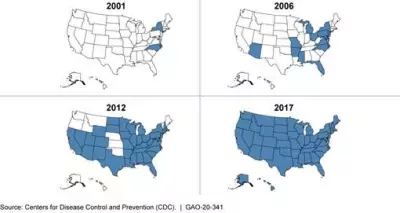Superbugs: Antibiotic-Resistant Bacterial Infections on the Rise
Some bacterial infections have become difficult, and sometimes impossible, to treat. That’s because the “superbugs” causing these infections have developed the ability to defeat antibiotics—the drugs designed to kill them. While antibiotics do not work on viral diseases like COVID-19, they may be useful in treating bacterial infections that sometimes develop in COVID-19 patients.
We recently reported on actions taken by the Centers for Disease Control and Prevention and other federal agencies to address this issue. And we made a number of recommendations to improve federal efforts to fight antibiotic resistance.
Today’s WatchBlog explores. You can also tune in to our podcast below to learn more.
A cause for concern
Antibiotic resistance is a growing issue. The figure below shows the cumulative spread of one type of resistant bacteria. In 2019, CDC reported 2.8 million cases of infections and 35,000 deaths from 18 antibiotic-resistant bacteria of concern, including the one tracked in the figure.
The Spread of One Type of Highly Resistant Bacteria, 2001-2017
Note: This figure tracks a type of carbapenem-resistant Enterobacteriaceae (CRE), which, according to CDC, is a “nightmare bacteria” resistant to nearly all available antibiotics. Blue shading shows states with at least one case of CRE that year or any previous year.
But the federal government’s efforts to track and prevent these superbugs are limited by a number of challenges, including:
- New treatments—There aren’t enough new antibiotics in development to meet the threat of resistance. This is largely due to an inadequate return on investment for drug companies because of low prices and a limited population of people with resistant infections.
- Antibiotic use—The appropriate use of antibiotics—giving patients the right antibiotic at the right time, in the right dose, and for the right duration—is an important tool to fight antibiotic resistance. However, federal agencies require only certain types of health care facilities (such as hospitals and nursing homes) to improve antibiotic use. And federal agencies do not generally require health care providers to report data on their prescribing of antibiotics to a centralized database.
- Surveillance—For some resistant bacteria, CDC collects a limited amount of data through its surveillance systems. For example, although it has classified resistant gonorrhea as an urgent threat that affects over half a million patients annually, its surveillance system currently only captures an estimated 1-2% of U.S. cases—and primarily in males.
- Diagnostics—Federal agencies have conducted some studies to establish whether patients benefit from diagnostic tests to identify antibiotic-resistant bacterial infections, but more studies are needed.
Improving federal efforts
We’ve made a number of recommendations to federal agencies to help improve how they combat bacterial resistance.
For example, CDC could work to increase the amount of data it collects on antibiotic resistance. The Department of Health and Human Services could also clarify roles and responsibilities for studying diagnostic tests, as well as develop a strategy to further incentivize the development of new treatments through the use of postmarket financial incentives.
Additionally, the federal government created a national action plan in 2015 to strengthen antibiotic stewardship and the timely reporting of antibiotic use data, among other things. However, the task force in charge of implementing this plan has yet to report on barriers to expanding antibiotic stewardship programs or to collecting antibiotic use data. We recommended that it do so.
To learn more about our findings and recommendation, check out our report.
- Comments on GAO’s WatchBlog? Contact blog@gao.gov.
GAO Contacts
Related Products

GAO's mission is to provide Congress with fact-based, nonpartisan information that can help improve federal government performance and ensure accountability for the benefit of the American people. GAO launched its WatchBlog in January, 2014, as part of its continuing effort to reach its audiences—Congress and the American people—where they are currently looking for information.
The blog format allows GAO to provide a little more context about its work than it can offer on its other social media platforms. Posts will tie GAO work to current events and the news; show how GAO’s work is affecting agencies or legislation; highlight reports, testimonies, and issue areas where GAO does work; and provide information about GAO itself, among other things.
Please send any feedback on GAO's WatchBlog to blog@gao.gov.






